GMC SIERRA 2004 Workshop Manual
Manufacturer: GMC, Model Year: 2004, Model line: SIERRA, Model: GMC SIERRA 2004Pages: 588, PDF Size: 3.74 MB
Page 51 of 588
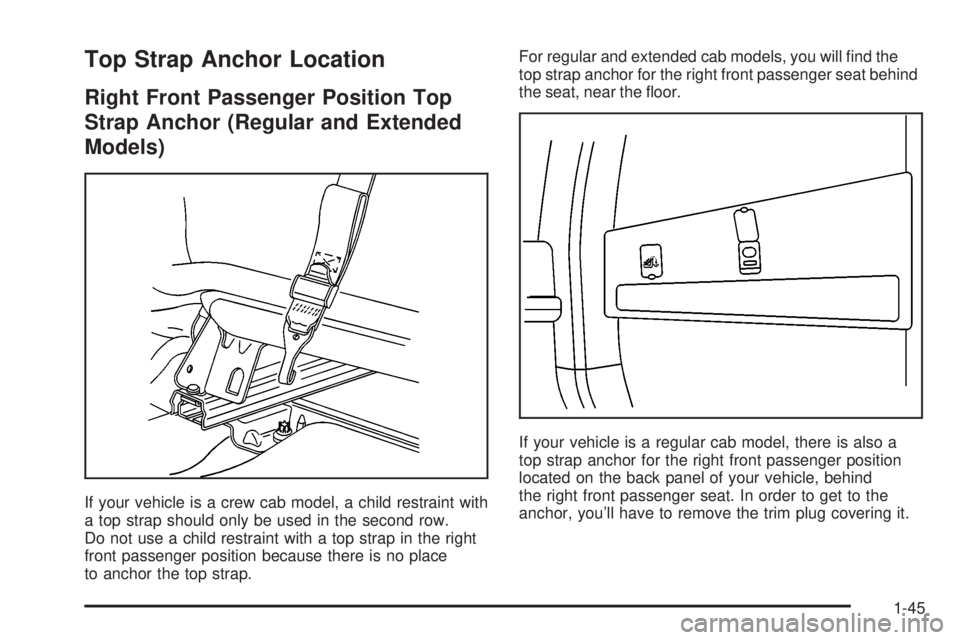
Top Strap Anchor Location
Right Front Passenger Position Top
Strap Anchor (Regular and Extended
Models)
If your vehicle is a crew cab model, a child restraint with
a top strap should only be used in the second row.
Do not use a child restraint with a top strap in the right
front passenger position because there is no place
to anchor the top strap.For regular and extended cab models, you will ®nd the
top strap anchor for the right front passenger seat behind
the seat, near the ¯oor.
If your vehicle is a regular cab model, there is also a
top strap anchor for the right front passenger position
located on the back panel of your vehicle, behind
the right front passenger seat. In order to get to the
anchor, you'll have to remove the trim plug covering it.
1-45
Page 52 of 588
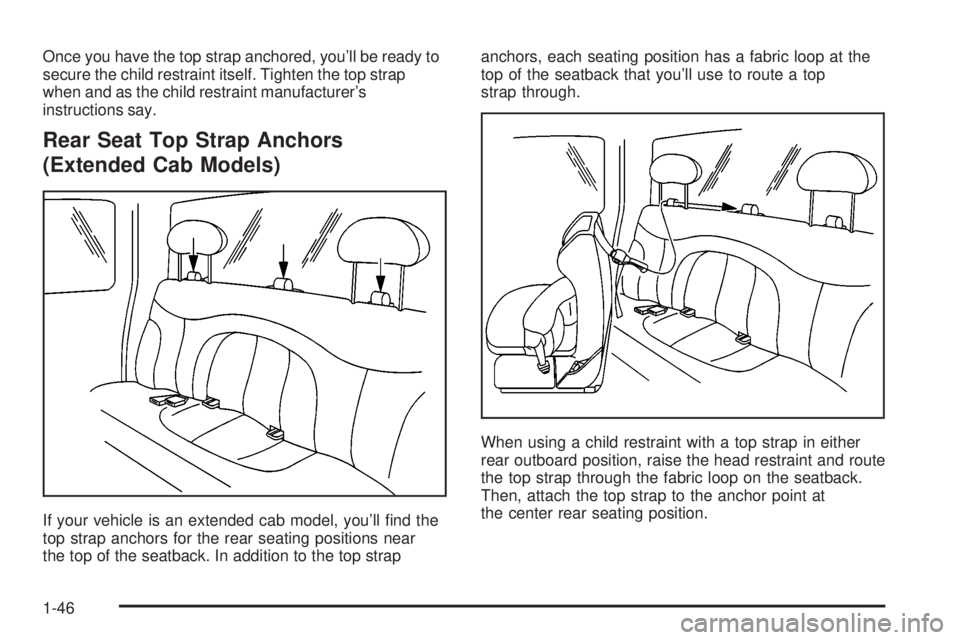
Once you have the top strap anchored, you'll be ready to
secure the child restraint itself. Tighten the top strap
when and as the child restraint manufacturer's
instructions say.
Rear Seat Top Strap Anchors
(Extended Cab Models)
If your vehicle is an extended cab model, you'll ®nd the
top strap anchors for the rear seating positions near
the top of the seatback. In addition to the top strapanchors, each seating position has a fabric loop at the
top of the seatback that you'll use to route a top
strap through.
When using a child restraint with a top strap in either
rear outboard position, raise the head restraint and route
the top strap through the fabric loop on the seatback.
Then, attach the top strap to the anchor point at
the center rear seating position.
1-46
Page 53 of 588
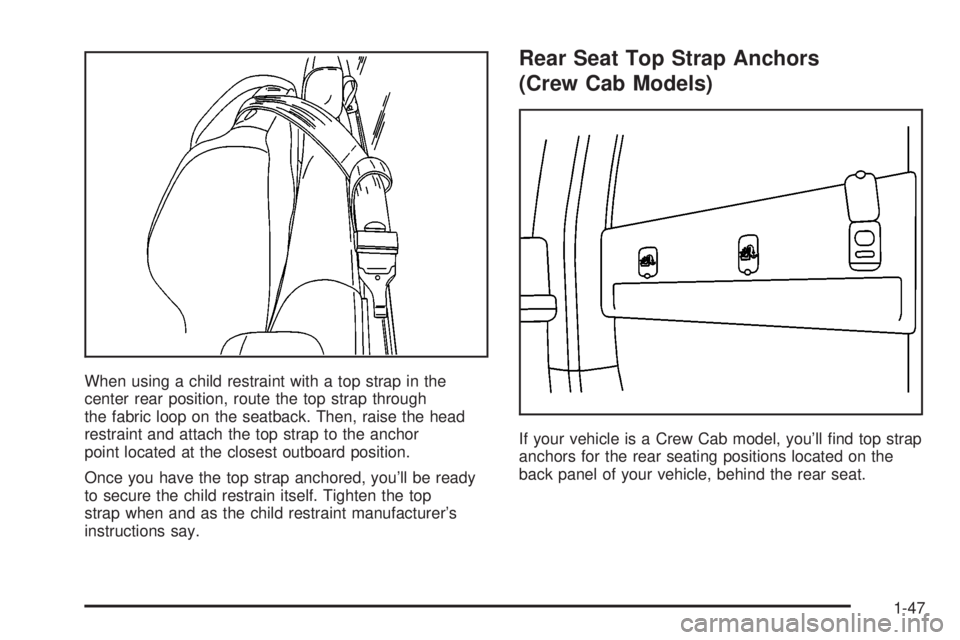
When using a child restraint with a top strap in the
center rear position, route the top strap through
the fabric loop on the seatback. Then, raise the head
restraint and attach the top strap to the anchor
point located at the closest outboard position.
Once you have the top strap anchored, you'll be ready
to secure the child restrain itself. Tighten the top
strap when and as the child restraint manufacturer's
instructions say.
Rear Seat Top Strap Anchors
(Crew Cab Models)
If your vehicle is a Crew Cab model, you'll ®nd top strap
anchors for the rear seating positions located on the
back panel of your vehicle, behind the rear seat.
1-47
Page 54 of 588
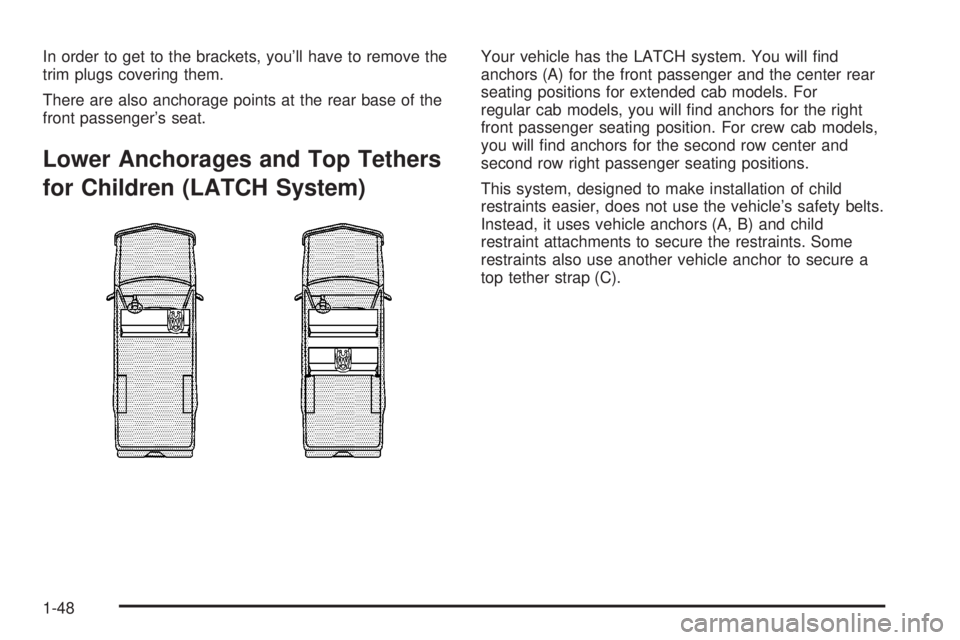
In order to get to the brackets, you'll have to remove the
trim plugs covering them.
There are also anchorage points at the rear base of the
front passenger's seat.
Lower Anchorages and Top Tethers
for Children (LATCH System)
Your vehicle has the LATCH system. You will ®nd
anchors (A) for the front passenger and the center rear
seating positions for extended cab models. For
regular cab models, you will ®nd anchors for the right
front passenger seating position. For crew cab models,
you will ®nd anchors for the second row center and
second row right passenger seating positions.
This system, designed to make installation of child
restraints easier, does not use the vehicle's safety belts.
Instead, it uses vehicle anchors (A, B) and child
restraint attachments to secure the restraints. Some
restraints also use another vehicle anchor to secure a
top tether strap (C).
1-48
Page 55 of 588
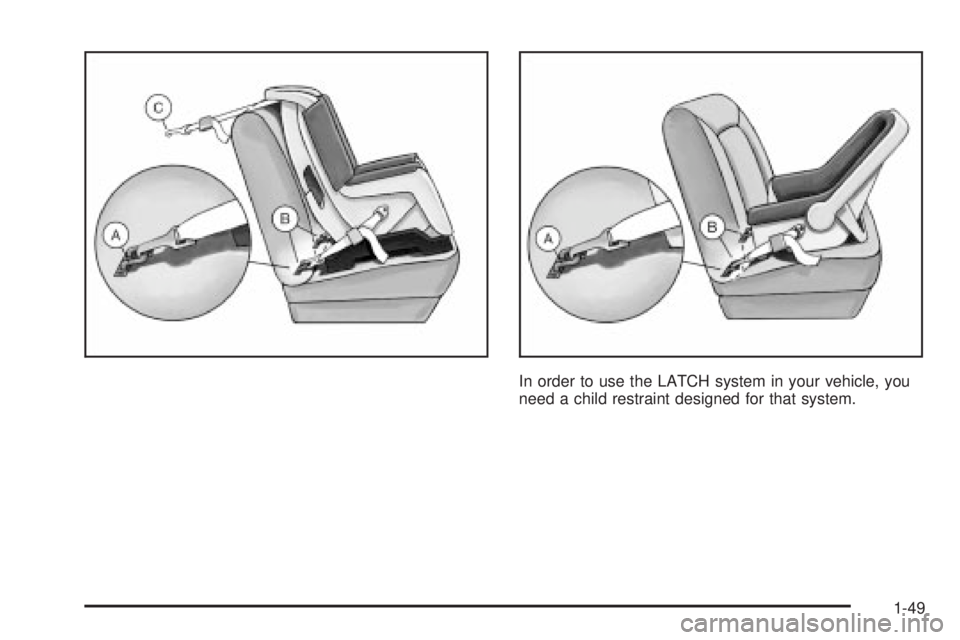
In order to use the LATCH system in your vehicle, you
need a child restraint designed for that system.
1-49
Page 56 of 588
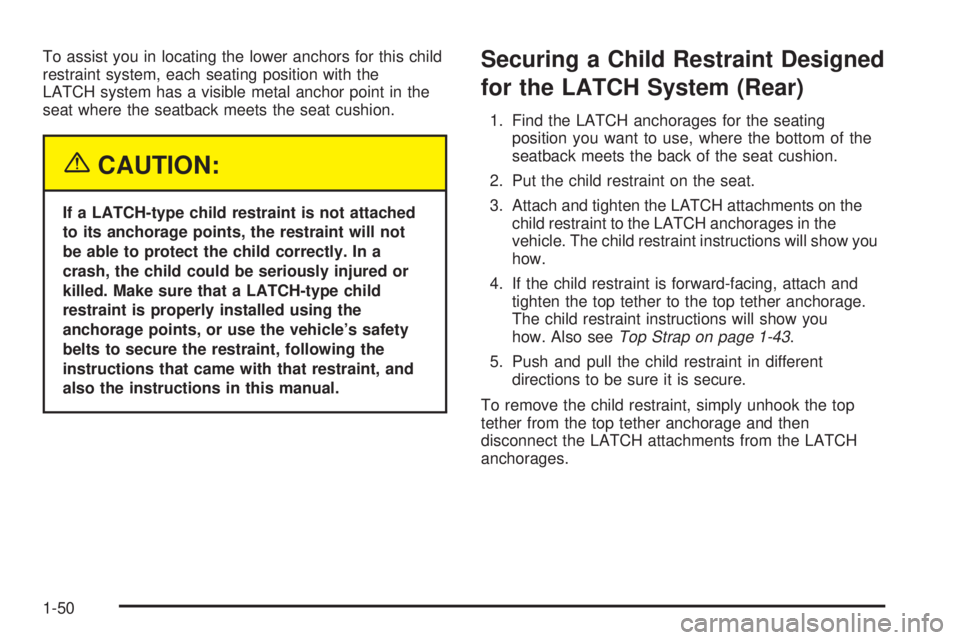
To assist you in locating the lower anchors for this child
restraint system, each seating position with the
LATCH system has a visible metal anchor point in the
seat where the seatback meets the seat cushion.
{CAUTION:
If a LATCH-type child restraint is not attached
to its anchorage points, the restraint will not
be able to protect the child correctly. In a
crash, the child could be seriously injured or
killed. Make sure that a LATCH-type child
restraint is properly installed using the
anchorage points, or use the vehicle's safety
belts to secure the restraint, following the
instructions that came with that restraint, and
also the instructions in this manual.
Securing a Child Restraint Designed
for the LATCH System (Rear)
1. Find the LATCH anchorages for the seating
position you want to use, where the bottom of the
seatback meets the back of the seat cushion.
2. Put the child restraint on the seat.
3. Attach and tighten the LATCH attachments on the
child restraint to the LATCH anchorages in the
vehicle. The child restraint instructions will show you
how.
4. If the child restraint is forward-facing, attach and
tighten the top tether to the top tether anchorage.
The child restraint instructions will show you
how. Also see
Top Strap on page 1-43.
5. Push and pull the child restraint in different
directions to be sure it is secure.
To remove the child restraint, simply unhook the top
tether from the top tether anchorage and then
disconnect the LATCH attachments from the LATCH
anchorages.
1-50
Page 57 of 588
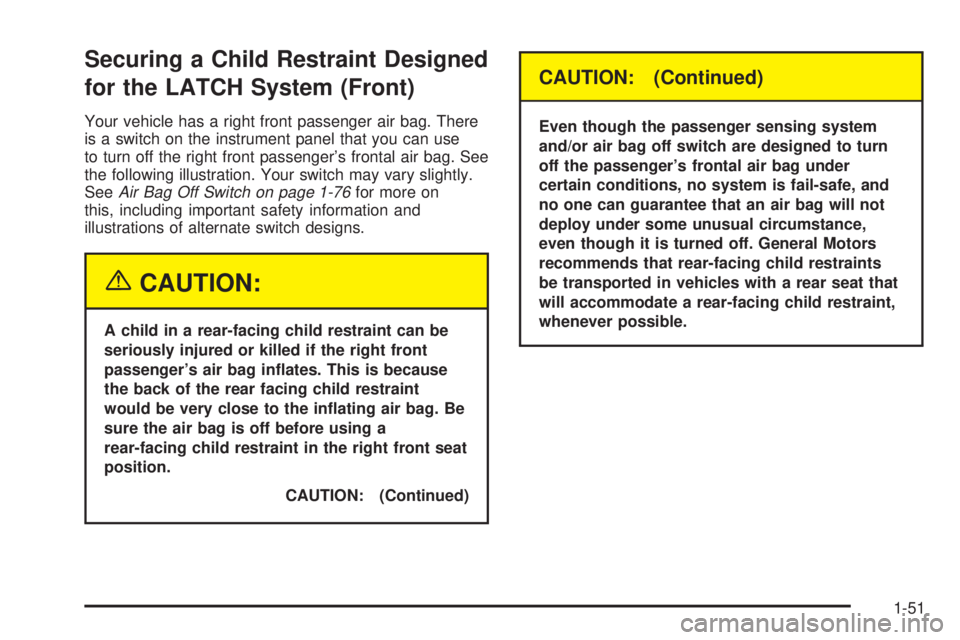
Securing a Child Restraint Designed
for the LATCH System (Front)
Your vehicle has a right front passenger air bag. There
is a switch on the instrument panel that you can use
to turn off the right front passenger's frontal air bag. See
the following illustration. Your switch may vary slightly.
See
Air Bag Off Switch on page 1-76for more on
this, including important safety information and
illustrations of alternate switch designs.
{CAUTION:
A child in a rear-facing child restraint can be
seriously injured or killed if the right front
passenger's air bag in¯ates. This is because
the back of the rear facing child restraint
would be very close to the in¯ating air bag. Be
sure the air bag is off before using a
rear-facing child restraint in the right front seat
position.
CAUTION: (Continued)
CAUTION: (Continued)
Even though the passenger sensing system
and/or air bag off switch are designed to turn
off the passenger's frontal air bag under
certain conditions, no system is fail-safe, and
no one can guarantee that an air bag will not
deploy under some unusual circumstance,
even though it is turned off. General Motors
recommends that rear-facing child restraints
be transported in vehicles with a rear seat that
will accommodate a rear-facing child restraint,
whenever possible.
1-51
Page 58 of 588
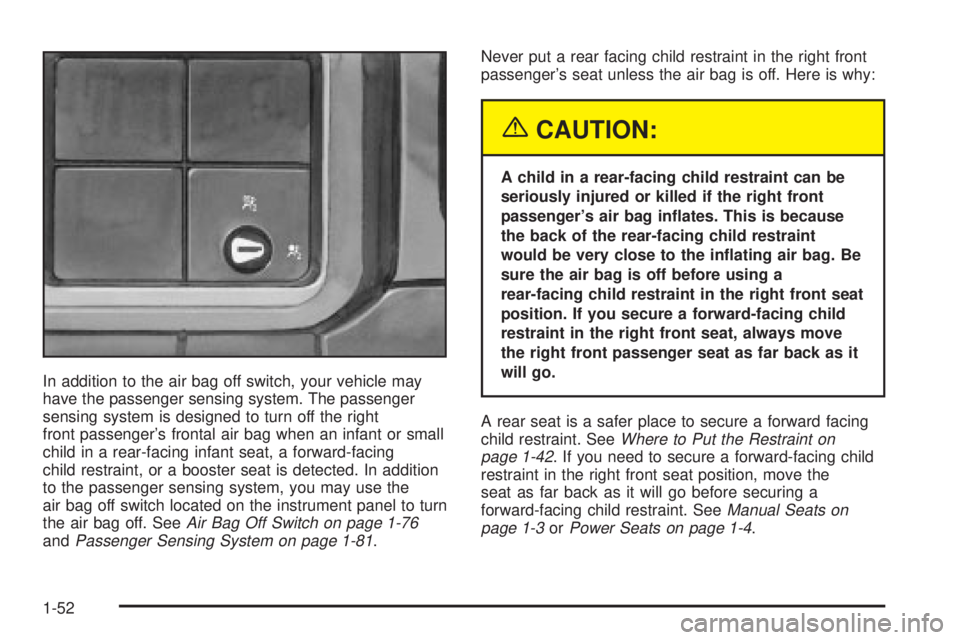
In addition to the air bag off switch, your vehicle may
have the passenger sensing system. The passenger
sensing system is designed to turn off the right
front passenger's frontal air bag when an infant or small
child in a rear-facing infant seat, a forward-facing
child restraint, or a booster seat is detected. In addition
to the passenger sensing system, you may use the
air bag off switch located on the instrument panel to turn
the air bag off. See
Air Bag Off Switch on page 1-76andPassenger Sensing System on page 1-81.Never put a rear facing child restraint in the right front
passenger's seat unless the air bag is off. Here is why:
{CAUTION:
A child in a rear-facing child restraint can be
seriously injured or killed if the right front
passenger's air bag in¯ates. This is because
the back of the rear-facing child restraint
would be very close to the in¯ating air bag. Be
sure the air bag is off before using a
rear-facing child restraint in the right front seat
position. If you secure a forward-facing child
restraint in the right front seat, always move
the right front passenger seat as far back as it
will go.
A rear seat is a safer place to secure a forward facing
child restraint. See
Where to Put the Restraint on
page 1-42. If you need to secure a forward-facing child
restraint in the right front seat position, move the
seat as far back as it will go before securing a
forward-facing child restraint. See
Manual Seats on
page 1-3orPower Seats on page 1-4.
1-52
Page 59 of 588
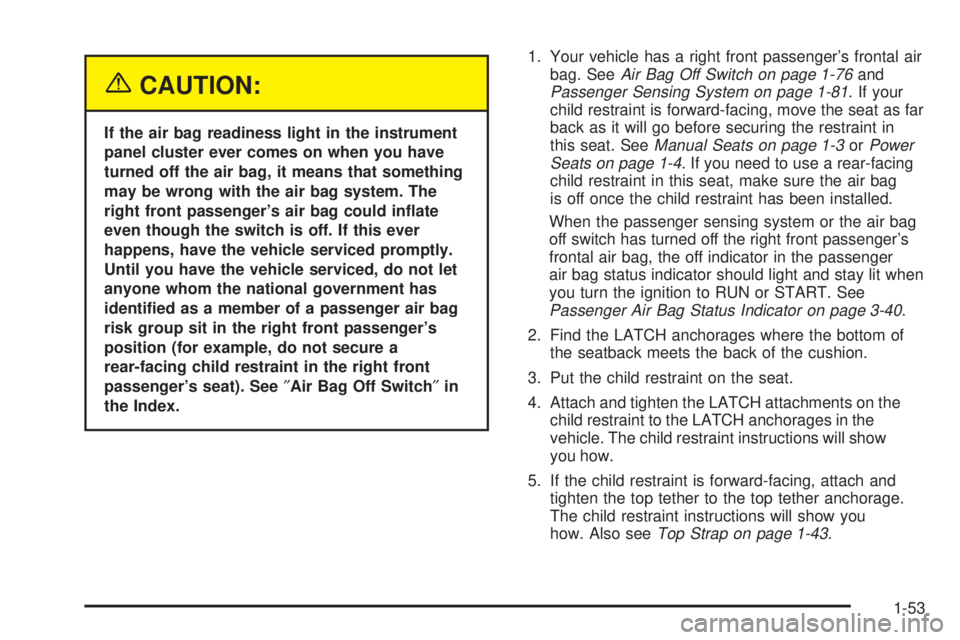
{CAUTION:
If the air bag readiness light in the instrument
panel cluster ever comes on when you have
turned off the air bag, it means that something
may be wrong with the air bag system. The
right front passenger's air bag could in¯ate
even though the switch is off. If this ever
happens, have the vehicle serviced promptly.
Until you have the vehicle serviced, do not let
anyone whom the national government has
identi®ed as a member of a passenger air bag
risk group sit in the right front passenger's
position (for example, do not secure a
rear-facing child restraint in the right front
passenger's seat). See²Air Bag Off Switch²in
the Index.1. Your vehicle has a right front passenger's frontal air
bag. See
Air Bag Off Switch on page 1-76andPassenger Sensing System on page 1-81. If your
child restraint is forward-facing, move the seat as far
back as it will go before securing the restraint in
this seat. See
Manual Seats on page 1-3orPower
Seats on page 1-4. If you need to use a rear-facing
child restraint in this seat, make sure the air bag
is off once the child restraint has been installed.
When the passenger sensing system or the air bag
off switch has turned off the right front passenger's
frontal air bag, the off indicator in the passenger
air bag status indicator should light and stay lit when
you turn the ignition to RUN or START. See
Passenger Air Bag Status Indicator on page 3-40.
2. Find the LATCH anchorages where the bottom of
the seatback meets the back of the cushion.
3. Put the child restraint on the seat.
4. Attach and tighten the LATCH attachments on the
child restraint to the LATCH anchorages in the
vehicle. The child restraint instructions will show
you how.
5. If the child restraint is forward-facing, attach and
tighten the top tether to the top tether anchorage.
The child restraint instructions will show you
how. Also see
Top Strap on page 1-43.
1-53
Page 60 of 588
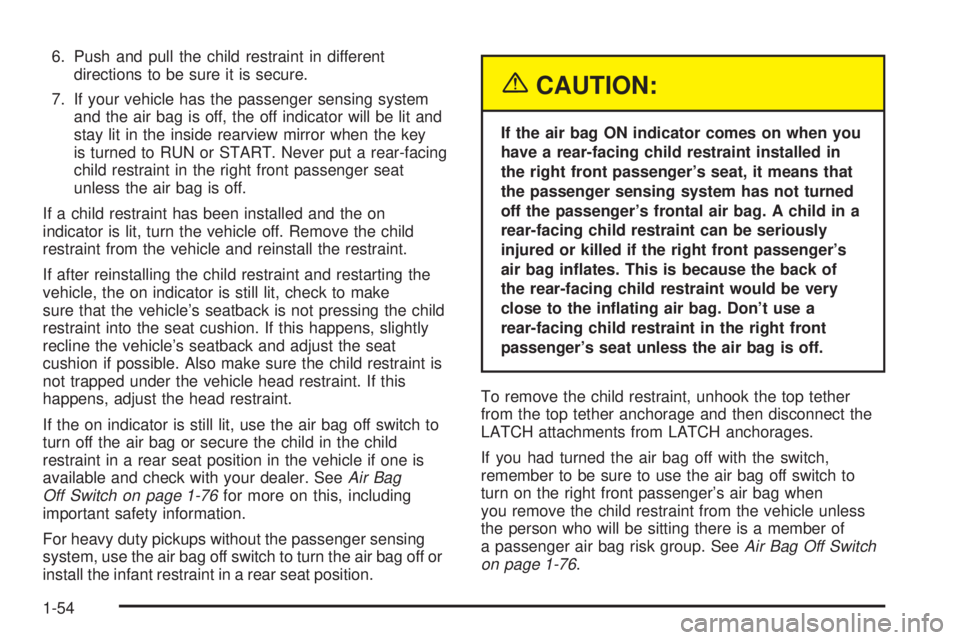
6. Push and pull the child restraint in different
directions to be sure it is secure.
7. If your vehicle has the passenger sensing system
and the air bag is off, the off indicator will be lit and
stay lit in the inside rearview mirror when the key
is turned to RUN or START. Never put a rear-facing
child restraint in the right front passenger seat
unless the air bag is off.
If a child restraint has been installed and the on
indicator is lit, turn the vehicle off. Remove the child
restraint from the vehicle and reinstall the restraint.
If after reinstalling the child restraint and restarting the
vehicle, the on indicator is still lit, check to make
sure that the vehicle's seatback is not pressing the child
restraint into the seat cushion. If this happens, slightly
recline the vehicle's seatback and adjust the seat
cushion if possible. Also make sure the child restraint is
not trapped under the vehicle head restraint. If this
happens, adjust the head restraint.
If the on indicator is still lit, use the air bag off switch to
turn off the air bag or secure the child in the child
restraint in a rear seat position in the vehicle if one is
available and check with your dealer. See
Air Bag
Off Switch on page 1-76for more on this, including
important safety information.
For heavy duty pickups without the passenger sensing
system, use the air bag off switch to turn the air bag off or
install the infant restraint in a rear seat position.
{CAUTION:
If the air bag ON indicator comes on when you
have a rear-facing child restraint installed in
the right front passenger's seat, it means that
the passenger sensing system has not turned
off the passenger's frontal air bag. A child in a
rear-facing child restraint can be seriously
injured or killed if the right front passenger's
air bag in¯ates. This is because the back of
the rear-facing child restraint would be very
close to the in¯ating air bag. Don't use a
rear-facing child restraint in the right front
passenger's seat unless the air bag is off.
To remove the child restraint, unhook the top tether
from the top tether anchorage and then disconnect the
LATCH attachments from LATCH anchorages.
If you had turned the air bag off with the switch,
remember to be sure to use the air bag off switch to
turn on the right front passenger's air bag when
you remove the child restraint from the vehicle unless
the person who will be sitting there is a member of
a passenger air bag risk group. See
Air Bag Off Switch
on page 1-76.
1-54